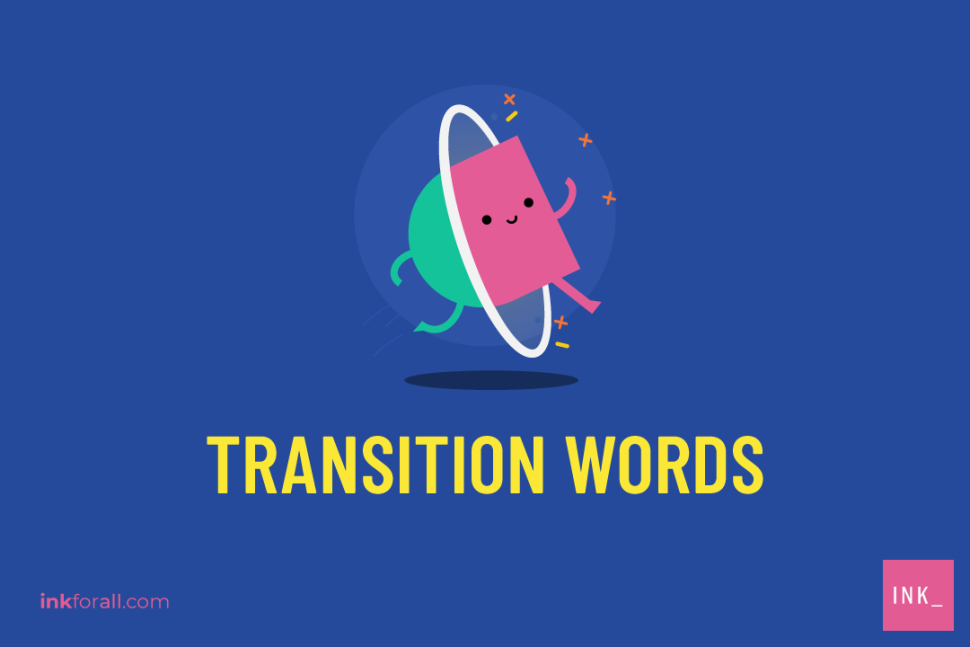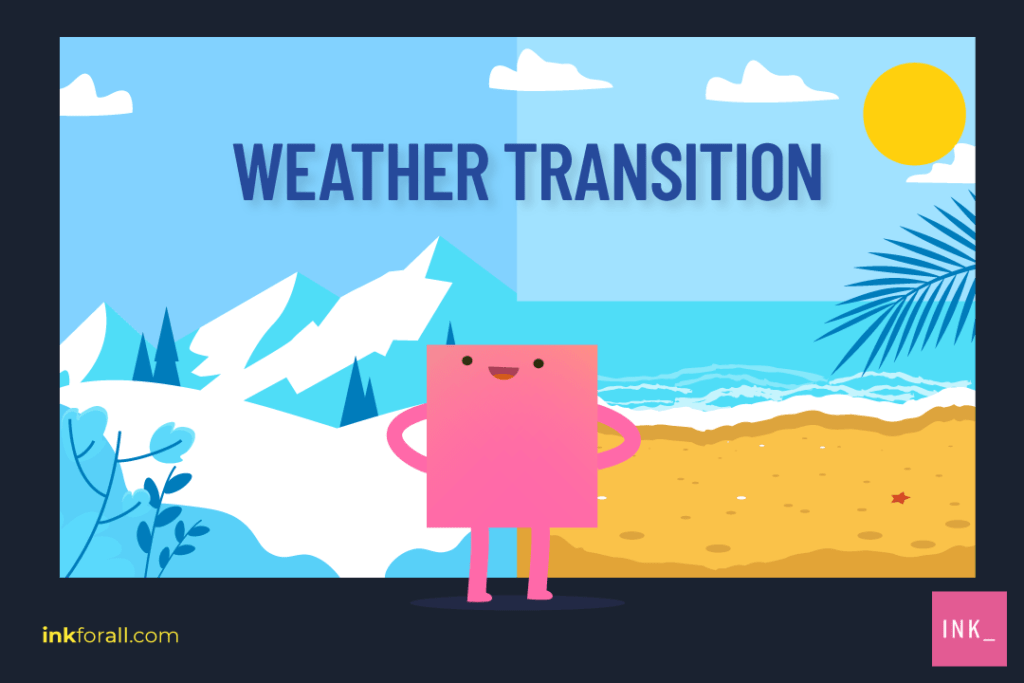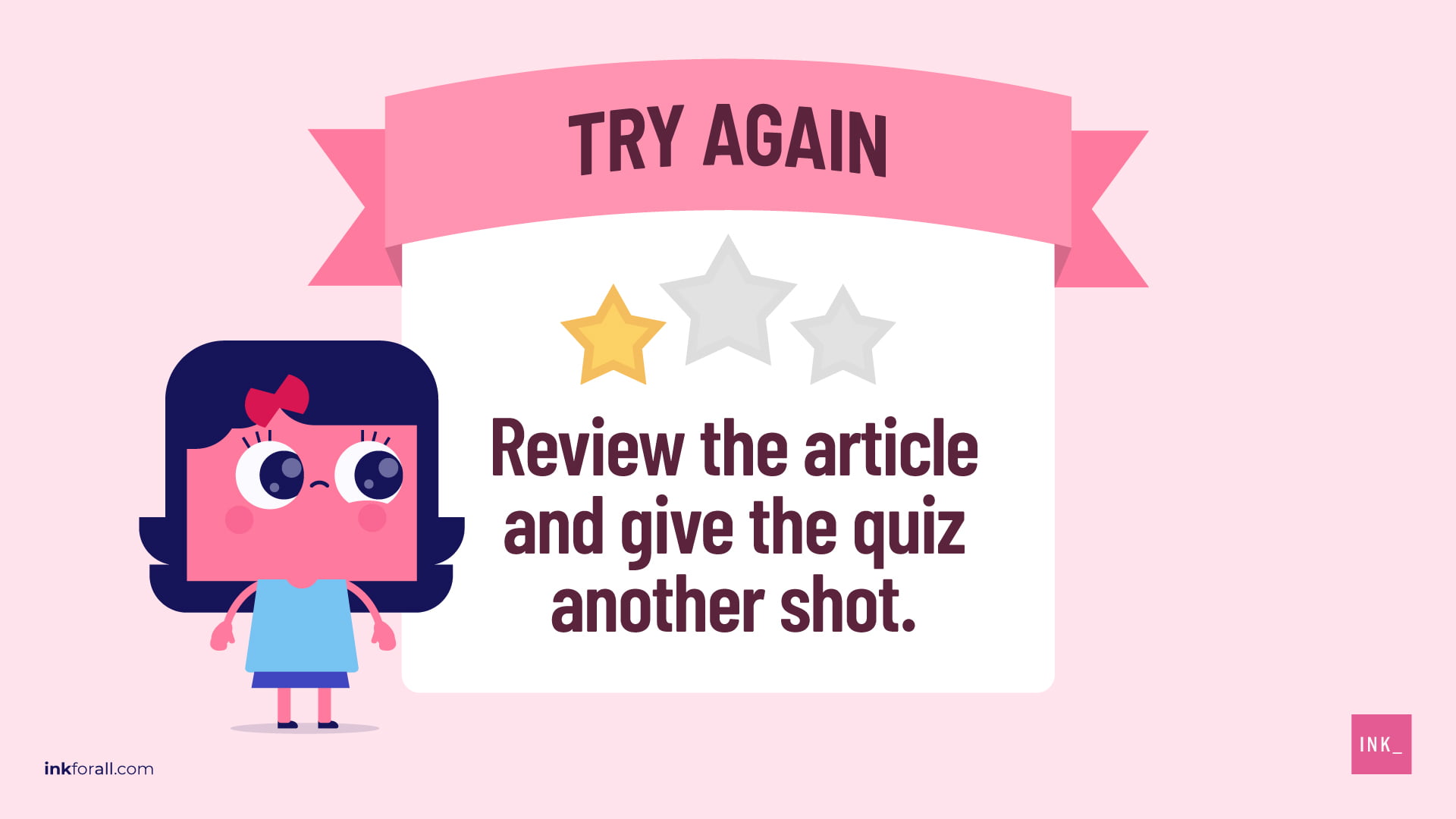Main Transition Words Takeaways:
- Transitional words are important because they help improve the flow between words, phrases, sentences, and paragraphs.
- They are important for SEO because they help make text easier to read and understand. Search engines and readers love content that is readable.
- Transition words help link ideas and statements.
- Using transitional words at the beginning or end of a paragraph can help the reader understand when you introduce a new topic.
- The four types of transition words are additive, adversative, causal, and sequential.
- Transition words and phrases don’t affect the grammatical structure of sentences and paragraphs.
What Are Transition Words?
As a writer, your primary goal is to present information and ideas to your target audience in a clear and understandable manner. The best way to do that is to use transition words. Transition words or transitional words are terms and phrases that help connect words, phrases, and even sentences together. They build connections between ideas in your content.
Transition words and phrases ensure that your written work will not look choppy and disjointed. They help your audience progress from one idea to the next. Think of them as a way to tell your readers how they should process and understand the information you are giving them. Transition words function like GPS, guiding your readers where they are going and how to get there.
What Are Some Examples Of Transition Words and Phrases?
Here are some of the most common examples of transition words and phrases:
Not to mention
Equally important
As a matter of fact
Not only/But Also
In addition
In fact
For example
What is more
In particular
On the other hand
When in fact
But even so
Whatever happens
In any case
Because of
Due to
In the event that
With this in mind
To conclude
By the way
To return to the subject
As has been mentioned
Given these points
Transition words are categorized based on their purpose. For instance, transition phrases like as a result of, due to, and as long as are used to emphasize cause and effect. Below are more examples of transition expressions that have been categorized based on their functions:
Cause and Effect
granted that
as long as
for the purpose of
in order to
in view of
as a result of
due to
because
therefore
consequently
so
accordingly
thus
hence
Since
for
owing to
as a consequence of
leads to
contributes of
stems from
comes from
results from
Evidence
as well as
and
too
also
in addition to
or
not only… but also
further
furthermore
besides
in addition
moreover
then
again
finally
by the same token
identically
uniquely
certainly
truly
including
to be sure
namely
chiefly
Contrast
however
on the other hand
otherwise
but
unlike
conversely
in spite of
at the same time
nevertheless
alternatively
on the contrary
yet
whereas
apart from
even so
although
while
Comparison
as
as if
similarly
equally
like
in the same way
comparable
as with
of contrast
despite this
in comparison
in contrast
even though
likewise
in like manner
Opinion
I feel
I believe
in my opinion
as fast as I know
in my experience
as for me, I think
if I’m not mistaken
I think
in my view
it seems likely
it seems to me
what I mean is
i’d say that
Similarity
moreover
as well as
together
of course
likewise
comparatively
correspondingly
similarly
furthermore
additionally
Clarification
that is to say
in other words
to clarify
that is
to explain
to put it another way
to rephrase it
in this case
I mean
up to a point
under certain circumstance
Sequence/ Order
first
second
next
finally
at this time
following
previously
before
prior to
before
Time
later
after
before
soon
meanwhile
during
subsequently
after that
at the present time
sooner or later
in due time
as long as
in the meantime
in a moment
at this instant
from time to time
Condition / Purpose
provided that
given that
in case
even if
only if
so as to
in as much as
when
whenever
if… then
unless
because of
as
while
lest
since
Emphasis
also
especially
furthermore
indeed
in addition
in particular
certainly
of course
significantly
notably
in fact
actually
in reality
as it happens
Conclusion
in conclusion
to conclude
finally
summarizing
overall
on the whole
to sum up
evidently
briefly
in short
altogether
in summary
to summarize
Place
here
there
over there
under
beyond
to the left
opposite
in the distance
Illustration
such as
in this case
for one thing
for example
in the case of
illustrated by
as an example
for instance
in other words
as revealed by
an instance
to show that
Reservation
admittedly
even so
as a matter of fact
indeed
nevertheless
even though
despite this
notwithstanding
regardless
What Are Some Examples of Transition Sentences?
The best way to understand how transitional words work is to see them in action. Remember, as important as these grammatical tools are, it’s not a good idea to overuse them. Too many transitional phrases can make your text seem complicated and wordy. It could also make you seem like a chronic overexplainer, and nobody wins when that happens.
You can use transitions to go from sentence to sentence:
You can also use transition words and phrases to go from paragraph to paragraph:
What Are the Four Types of Transition Words?
There are a lot of different ways to categorize transition words. In this post, we will discuss the four main types of transition words: Additive, Adversative, Causal, and Sequential.
1. What are Additive Transitions?
These transition words add or introduce another idea. They may also reference a previously mentioned concept, identify a similarity, or clarify an idea. Additive transitional words include:
2. What are Adversative Transitions?
Adversative transitions may be used to signal opposing ideas or dismiss a previously discussed idea altogether. Some adversative transition words include:
3. What are Causal Transitions?
As for causal transitions, they’re most commonly used to denote cause and effect. They may also indicate the reason an idea or action is happening or has happened. Causal transition words include:
4. What are Sequential Transitions?
As the name suggests, sequential transitions are used to put a sequence of ideas in order (usually chronological). This helps the reader understand where ideas fall in a list or when you’re wrapping up your text. Sequential transitions include:
Are Conjunctions Considered Transition Words?
While conjunctions and transitions share the same purpose — to connect ideas between or within sentences — they are not used the same way. You must not confuse conjunctions with transitional words or expressions. Conjunctions connect phrases and clauses, whereas transitions indicate the relationship between sentences and paragraphs. Check the following examples:
Subordinating conjunctions connecting dependent clauses with independent clauses:
Read More: The Easiest Way To Get Subordinating Conjunctions
Coordinating conjunctions connecting two independent clauses:
Transition words connecting sentences and paragraphs:
Another significant difference between transitions and conjunctions is their grammatical functions. Since conjunctions join clauses, they become part of the sentence and affect it grammatically. On the other hand, transition words have no impact on the grammatical structure of a sentence or paragraph. In short, you can remove a transition word, and it won’t have any impact on the sentence at all. Check the examples below:
Do Commas Go Before Or After Transition Words?
The placement of commas when using transition words will depend on where the latter appears in your text.
If your transition phrase appears at the beginning of the sentence, it is always set off with a comma.
If the transition word or phrase appears within an independent clause, it should be preceded by and set off with a comma.
If the transitional word appears between two independent clauses in a compound sentence, it should be preceded by a semicolon and set off with a comma.
How Are Transition Words Used in SEO?
SEO, or search engine optimization, is a process that involves optimizing your content for search engines to help improve ranking. The higher you are in search results, the more visibility your content will have. The more visible your content, the more people will see and learn about your brand.
Unlike keywords or meta tags, transitions between sentences or paragraphs don’t directly help boost your search ranking. Instead, it’s all about readability and structure.
See, Google runs on algorithms and those algorithms are big fans of order and ease of use. In other words, clarity is everything.
In the olden days (you know, like the 2010s), Google was like a heat-seeking missile for keywords. Basically, the more keywords you could stuff in your copy, the better you’d rank. That led to a lot of web pages that said something like, “buckets buckets buy some buckets buckets for sale the best buckets.”
What are they selling? You guessed it: buckets!
Google (and the rest of the world) soon realized the keyword stuffing wasn’t really good for anyone. Instead, search engines began focusing on how web pages could best serve the reader. Now, algorithms analyze web content for readability, and transition words play a huge role in that determination.

Transition Words Give Direction
Transition words also help you structure your content. Remember our road map? Transitional words can act as street signs, pointing readers left or right, directing them to take a U-turn, or propelling them onward.
Bottom line: Transition words make your content easier to read and understand. For this reason, it’s vital to rely not only on helpful tools but also on your own mind. If it reads well to you, it’ll likely read well to your audience.
Transition To a Closing
Finally, you can use transitions to introduce a new section or conclude your previous one—or wrap up the entire text. You may even use a transition to reinforce the general idea of your content before ending your piece:
Quick Transition Words Grammar Quiz
Transition Words Question #1
A. Causal
B. Additive
C. Adversative
D. Sequential
Correct!
Wrong!
The correct answer is letter C. Adversative transition words may be used to signal opposing ideas or dismiss a previously discussed idea altogether.
(E.g., but, however, conversely, still, and besides)
Causal Transition Question #2
A. Additionally
B. Consequently
C. Either way
D. To illustrate
Correct!
Wrong!
The correct answer is letter B. Consequently along with words like for, since, unless, as a result, and hence are all causal transition words.
(E.g., «Flexible workers often find themselves in great demand, and consequently, earn high wages.»)
Transition Words in SEO Question #3
A. They make content more interesting.
B. They make content easier to read.
C. They help increase word count.
D. Trick question! They’re not important for SEO at all.
Correct!
Wrong!
The correct answer is letter B. Transition words help improve the flow of ideas within a piece of content, making it more readable and easy to understand. Content with a high readability score can boost your SEO.
Transition Words Quiz Result
You’re an expert!
Not Bad!
Almost got it! Review the article and try again.
Read More: How to use a question mark (?)
Transition Words: What They Are and Why You Should Use Them
powered by
LanguageTool
Transition words are essential. But do you know why? We’ll cover what they are and why they improve the flow of your writing.
- Transition words link your paragraphs and ideas to each other.
- If you want to improve the flow of your writing, make sure to include transitional words and phrases.
What Are “Transitions Words”?
Transition words (also known as transitional expressions) help guide your readers from one idea to the next. Readers don’t like abrupt changes, and they can be thrown off if you suddenly start talking about a different point or idea. Transition words improve the flow of your writing by linking paragraphs to each other. There is a myriad of transitional words and phrases you can include in your writing. We’ll cover the various types below.
There are several types of transition words that serve different functions. Below, you’ll find a table with examples of transition words.
| Type of Transition Word | Function | Examples |
|---|---|---|
| Addition | Shows your readers that the following paragraph adds to the main point of your previous one. | Additionally, Furthermore, Indeed, In addition, Moreover, In fact, What is more, |
| Cause and Effect | Signals that certain circumstances, events, or points were caused by others. | Accordingly, As a result, Because, Consequently, Therefore, For this purpose, Hence, |
| Comparison | Indicates the similarities between the idea you just wrote about and the upcoming paragraph. | Again, Also, In the same way, Likewise, Once more, Similarly |
| Contrast | Indicates the differences between the idea you just wrote about and the upcoming paragraph. | Although, Even though, Despite, However, In contrast, In spite of, Nonetheless, On the contrary, |
| Sequence | Expresses a numerical sequence. | Again, Also, And then, Finally, First, Second, Third, Next, Still, Furthermore, |
| Time | Helps readers understand the chronological order of events. | After, Afterward, As soon as, At last, Before, Earlier, Meanwhile, In the meantime, Then, Later |
| Summary or Conclusion | Shows your readers that they’ve reached a summary or conclusion paragraph. | As a result, In short, All in all, In conclusion, To summarize, As has been noted, As mentioned earlier, |
In Short, Transition Words and Phrases Improve Your Writing
If you want seamless writing, then transition words are vital. They help prepare your readers by letting them know how the upcoming text is relevant to what you just wrote. As essential as transition words are, they aren’t magical. Even properly placed transition words cannot undo the damage of having spelling and grammar mistakes. Luckily, LanguageTool can detect several types of errors, and it will offer corrections. Additionally, this multilingual text editor can provide synonyms and suggest stylistic improvements that’ll enhance your writing.
Unleash the Professional Writer in You With LanguageTool
Go well beyond grammar and spell checking. Impress with clear, precise, and stylistically flawless writing instead.
Get started for free
We Value Your Feedback
We’ve made a mistake, forgotten about an important detail, or haven’t managed to get the point across? Let’s help each other to perfect our writing.
One of your primary goals as a writer is to present ideas in a clear and understandable way. To help readers move through your complex ideas, you want to be intentional about how you structure your paper as a whole as well as how you form the individual paragraphs that comprise it. In order to think through the challenges of presenting your ideas articulately, logically, and in ways that seem natural to your readers, check out some of these resources: Developing a Thesis Statement, Paragraphing, and Developing Strategic Transitions: Writing that Establishes Relationships and Connections Between Ideas.
While clear writing is mostly achieved through the deliberate sequencing of your ideas across your entire paper, you can guide readers through the connections you’re making by using transitional words in individual sentences. Transitional words and phrases can create powerful links between your ideas and can help your reader understand your paper’s logic.
In what follows, we’ve included a list of frequently used transitional words and phrases that can help you establish how your various ideas relate to each other. We’ve divided these words and phrases into categories based on the common kinds of relationships writers establish between ideas.
Two recommendations:
Use these transitions strategically by making sure that the word or phrase you’re choosing matches the logic of the relationship you’re emphasizing or the connection you’re making. All of these words and phrases have different meanings, nuances, and connotations, so before using a particular transitional word in your paper, be sure you understand its meaning and usage completely, and be sure that it’s the right match for your paper’s logic.
Use these transitional words and phrases sparingly because if you use too many of them, your readers might feel like you are overexplaining connections that are already clear.
Categories of Transition Words and Phrases
Transitions to help establish some of the most common kinds of relationships
Causation–Connecting instigator(s) to consequence(s).
accordingly
as a result
and so
because
consequently
for that reason
hence
on account of
since
therefore
thus
Chronology–Connecting what issues in regard to when they occur.
after
afterwards
always
at length
during
earlier
following
immediately
in the meantime
later
never
next
now
once
simultaneously
so far
sometimes
soon
subsequently
then
this time
until now
when
whenever
while
Combinations
Lists–Connecting numerous events.
Part/Whole–Connecting numerous elements that make up something bigger.
additionally
again
also
and, or, not
as a result
besides
even more
finally
first, firstly
further
furthermore
in addition
in the first place
in the second place
last, lastly
moreover
next
second, secondly, etc.
too
Contrast–Connecting two things by focusing on their differences.
after all
although
and yet
at the same time
but
despite
however
in contrast
nevertheless
nonetheless
notwithstanding
on the contrary
on the other hand
otherwise
though
yet
Example–Connecting a general idea to a particular instance of this idea.
as an illustration
e.g., (from a Latin abbreviation for “for example”)
for example
for instance
specifically
that is
to demonstrate
to illustrate
Importance–Connecting what is critical to what is more inconsequential.
chiefly
critically
foundationally
most importantly
of less importance
primarily
Location–Connecting elements according to where they are placed in relationship to each other.
above
adjacent to
below
beyond
centrally
here
nearby
neighboring on
opposite to
peripherally
there
wherever
Similarity–Connecting to things by suggesting that they are in some way alike.
by the same token
in like manner
in similar fashion
here
in the same way
likewise
wherever
Other kinds of transitional words and phrases
Clarification
i.e., (from a Latin abbreviation for “that is”)
in other words
that is
that is to say
to clarify
to explain
to put it another way
to rephrase it
Intensification
in fact
indeed
no
of course
surely
to repeat
undoubtedly
without doubt
yes
Purpose
for this purpose
in order that
so that
to that end
to this end








